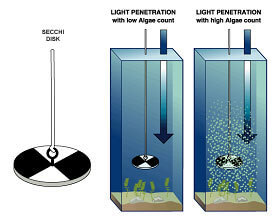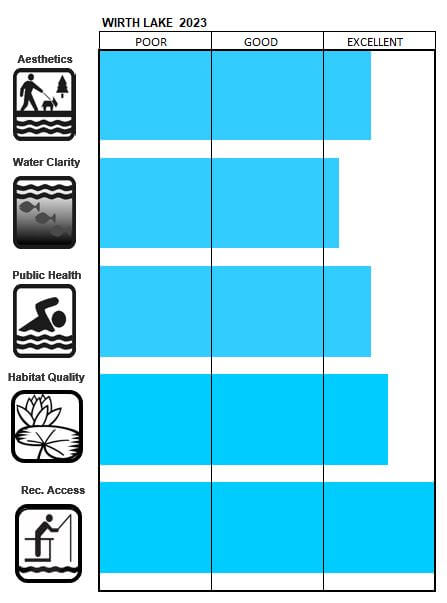The score for each lake is based on the geometric mean number of Escherichia coli (E. coli) collected by the beach monitoring program (Table 1-1). Lakes with more than one beach were averaged together. EPA and Minnesota guidelines state that beaches should not exceed a geometric mean of 126 organisms per 100 mL during a 30-day time period. Lower numbers of organisms indicate less risk of illnesses for lake users.
Table 1-1. Scoring for the public health portion of LAURI.
| E. coli, (CFU/100mL)* | Score |
| <2 (ND) | 10 |
| 2-10 | 9 |
| 11-20 | 8 |
| 21-35 | 7 |
| 36-50 | 6 |
| 51-65 | 5 |
| 66-80 | 4 |
| 81-100 | 3 |
| 101-125 | 2 |
| >126 | 1 |
* The value used is the running geometric mean for the year, averaged for all the beaches on a lake.








 To measure water transparency with a Secchi disk, the disk is lowered from the shaded side of a boat until it cannot be seen. The depth of the water is recorded at the point where the disk reappears upon raising it from its original depth beyond visibility. It is important to remember that the Secchi measurement is a simple, approximate measurement of water clarity and can be influenced by various factors such as time of day, reader’s eyesight, water color and suspended particles in the water. Therefore, Secchi disk readings should be used as a comparative tool to determine trends between lakes and over time.
To measure water transparency with a Secchi disk, the disk is lowered from the shaded side of a boat until it cannot be seen. The depth of the water is recorded at the point where the disk reappears upon raising it from its original depth beyond visibility. It is important to remember that the Secchi measurement is a simple, approximate measurement of water clarity and can be influenced by various factors such as time of day, reader’s eyesight, water color and suspended particles in the water. Therefore, Secchi disk readings should be used as a comparative tool to determine trends between lakes and over time.